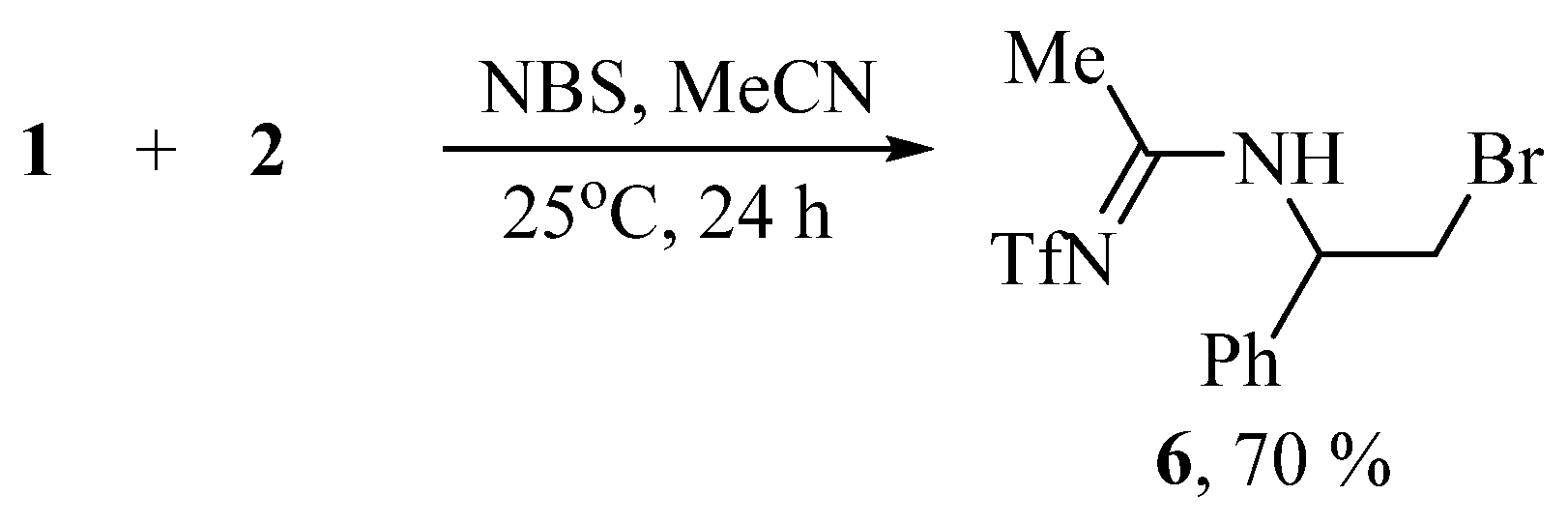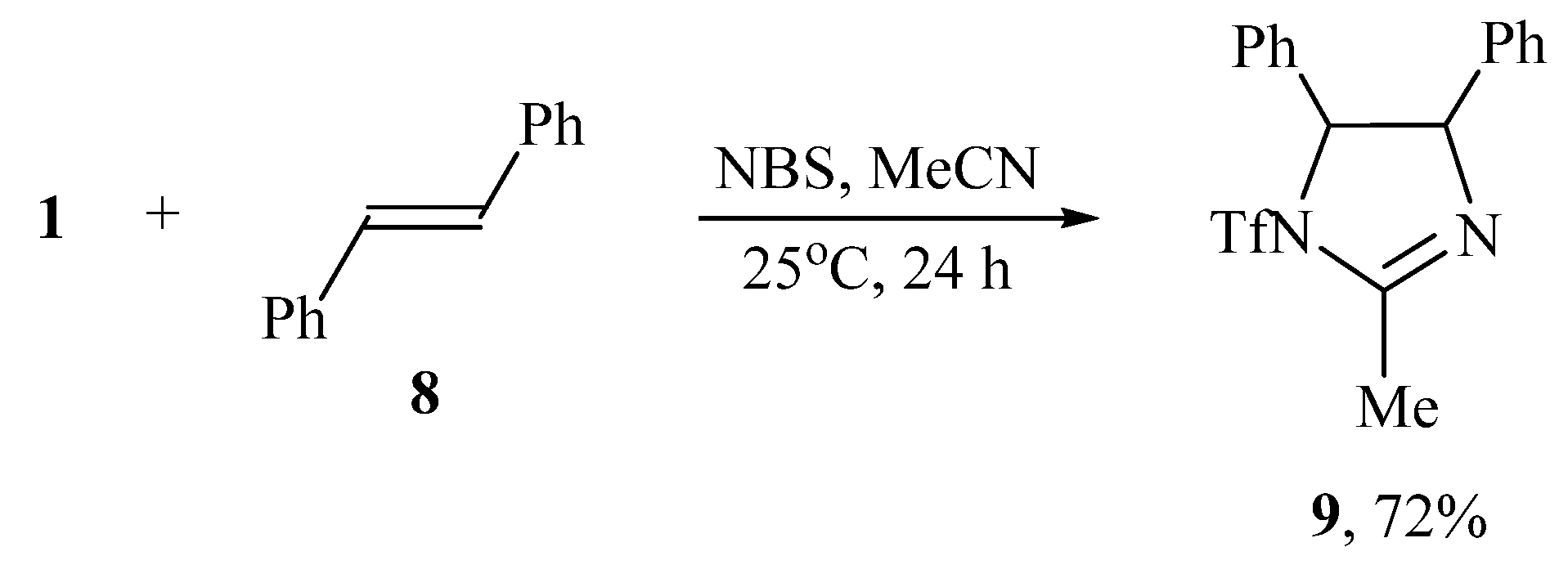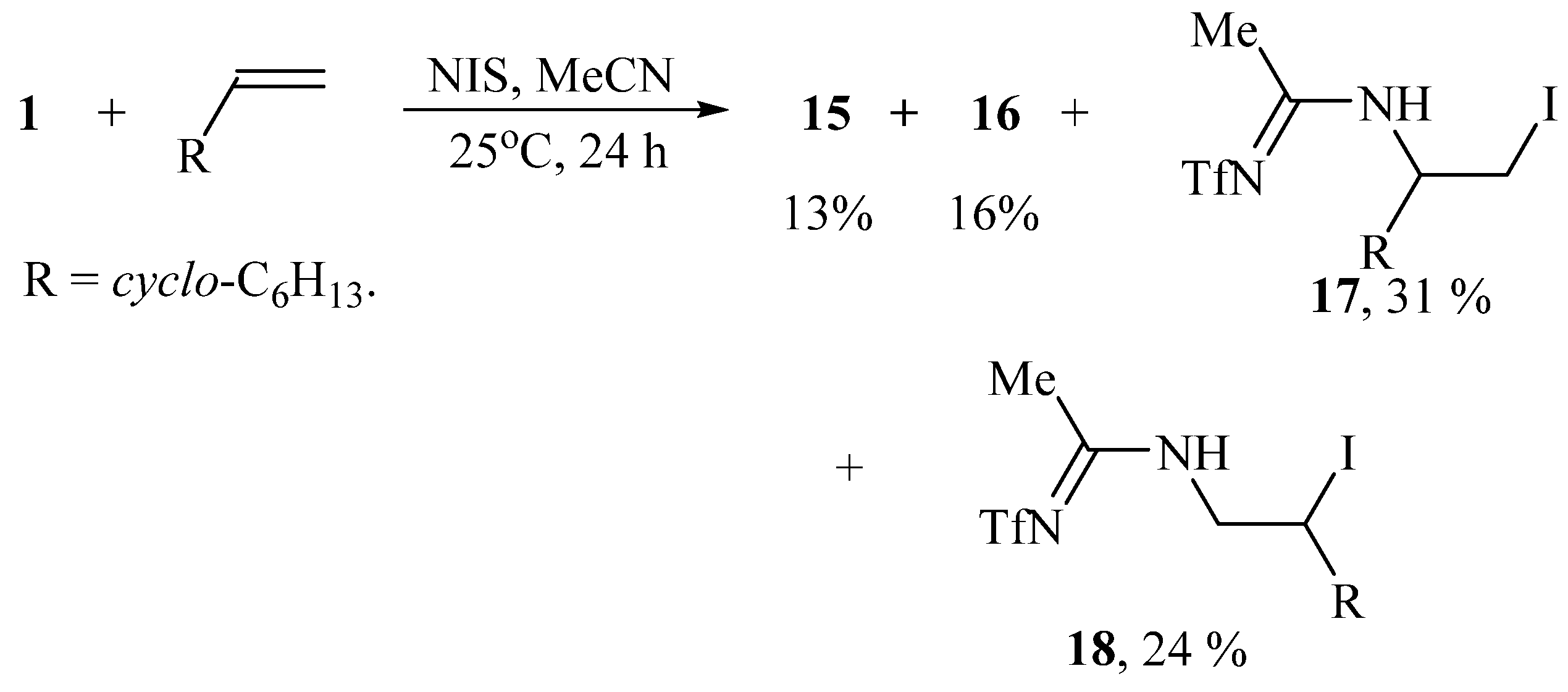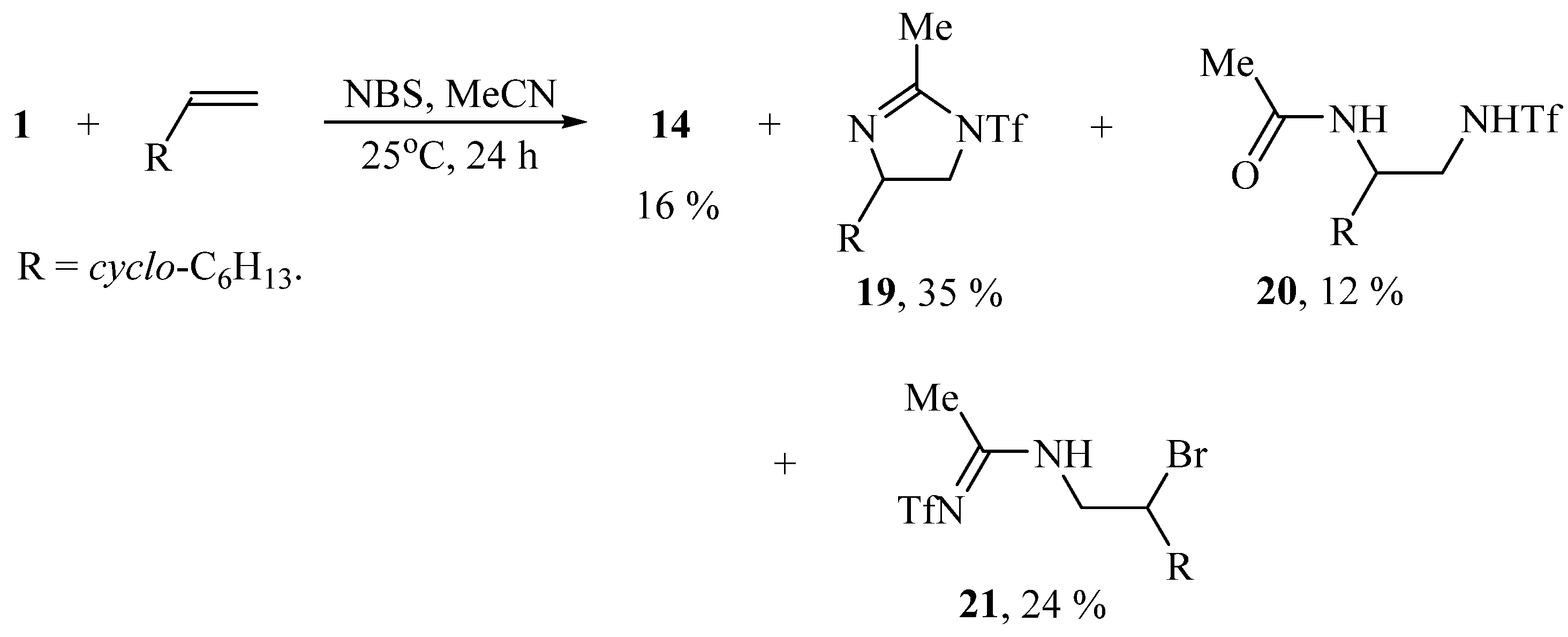The Reactions of Alkenes with Phenyl-N-triflylimino-λ3-iodane: Solvent and Oxidant Impact
Abstract
:1. Introduction
2. Results and Discussion
3. Materials and Methods
3.1. General Details
3.2. Synthesis of Compounds
3.2.1. Synthesis of Phenyl-N-triflylimino-λ3-iodane 1
3.2.2. Reaction of PhI=NTf 1 with Styrene in the System NXS–CH2Cl2
3.2.3. Reaction of PhI=NTf 1 with Styrene in the System NXS–MeCN
3.2.4. Reaction of PhI=NTf 1 with Styrene in the System I2–NaI–MeCN
3.2.5. Reaction of PhI=NTf 1 with Stilbene in the System NXS-MeCN
3.2.6. Reaction of PhI=NTf 1 with Stilbene in the System NBS(NIS)-CH2Cl2
3.2.7. Reaction of PhI=NTf 1 with Vinylcyclohexane in the System NBS(NIS)-CH2Cl2
3.2.8. Reaction of PhI=NTf 1 with Vinylcyclohexane in the System NIS-MeCN
3.2.9. Reaction of PhI=NTf 1 with Vinylcyclohexane in the System NBS-MeCN
4. Conclusions
Supplementary Materials
Author Contributions
Funding
Institutional Review Board Statement
Informed Consent Statement
Data Availability Statement
Acknowledgments
Conflicts of Interest
References
- Shainyan, B.A.; Tolstikova, L.L. Trifluoromethanesulfonamides and Related Compounds. Chem. Rev. 2013, 113, 699–733. [Google Scholar] [CrossRef] [PubMed]
- Moskalik, M.Y.; Astakhova, V.V. Triflamides and Triflimides: Synthesis and Applications. Molecules 2022, 27, 5201. [Google Scholar] [CrossRef] [PubMed]
- Shainyan, B.A. Recent trends in the chemistry of triflamides. Tetrahedron 2023, 147, 133662. [Google Scholar] [CrossRef]
- Moss, T.A.; Barber, D.M.; Kyle, A.F.; Dixon, D.J. Catalytic Asymmetric Alkylation Reactions for the Construction of Protected Ethylene-Amino and Propylene-Amino Motifs Attached to Quaternary Stereocentres. Chem. Eur. J. 2013, 19, 3071–3081. [Google Scholar] [CrossRef]
- Moss, T.A.; Fenwick, D.R.; Dixon, D.J. Enantio- and Diastereoselective Catalytic Alkylation Reactions with Aziridines. J. Am. Chem. Soc. 2008, 130, 10076–10077. [Google Scholar] [CrossRef]
- Cernerud, M.; Adolfsson, H.; Moberg, C. C3-symmetric tripodal tetra-amines—Preparation from chiral amino alcohols via aziridines. Tetrahedron Asymmetry 1997, 8, 2655–2662. [Google Scholar] [CrossRef]
- Pandey, P.; Bera, J.K. Hydrosilylative reduction of primary amides to primary amines catalyzed by a terminal [Ni–OH] complex. Chem. Commun. 2021, 57, 9204–9207. [Google Scholar] [CrossRef]
- Sarbajna, A.; Pandey, P.; Rahaman, S.M.W.; Singh, K.; Tyagi, A.; Dixneuf, P.H.; Bera, J.K. A Triflamide-Tethered N-Heterocyclic Carbene–Rhodium(I) Catalyst for Hydroalkoxylation Reactions: Ligand-Promoted Nucleophilic Activation of Alcohols. ChemCatChem 2017, 9, 1397–1401. [Google Scholar] [CrossRef]
- Liu, Z. (S)-N-Trifluoromethylsulfonyl-2-isopropylaziridine. In Encyclopedia of Reagents for Organic Synthesis (EROS); Wiley: Hoboken, NJ, USA, 2007. [Google Scholar]
- Duncan, A.P.; Leighton, J.L. Enantioselective Cu-Catalyzed Conjugate Addition of Diethylzinc to Acyclic Aliphatic Enones. Org. Lett. 2004, 6, 4117–4119. [Google Scholar] [CrossRef]
- Nelson, S.G.; Zhu, C.; Shen, X. Catalytic Asymmetric Acyl Halide−Aldehyde Cyclocondensation Reactions of Substituted Ketenes. J. Am. Chem. Soc. 2004, 126, 14–15. [Google Scholar] [CrossRef]
- Krauss, I.J.; Leighton, J.L. Highly Practical and Enantioselective Cu-Catalyzed Conjugate Addition of Alkylzinc Reagents to Cyclic Enones at Ambient Temperature. Org. Lett. 2003, 5, 3201–3203. [Google Scholar] [CrossRef] [PubMed]
- Lake, F.; Moberg, C. Sulfonamide Ligands from Chiral Aziridines—Application to the Titanium-Mediated Addition of Diethylzinc to Benzaldehyde. Eur. J. Org. Chem. 2002, 2002, 3179–3188. [Google Scholar] [CrossRef]
- Cernerud, M.; Skrinning, A.; Bérgère, I.; Moberg, C. Bis(ethylsulfonamide)amines via nucleophilic ring-opening of chiral aziridines. Application to Ti-mediated addition of diethylzinc to benzaldehyde. Tetrahedron Asymmetry 1997, 8, 3437–3441. [Google Scholar] [CrossRef]
- Xu, Y.; Zhu, S. A new route to fluorine-containing aziridines and α-amino esters. Tetrahedron 2001, 57, 669–674. [Google Scholar] [CrossRef]
- Xu, Y.; Xu, G.; Zhu, S.; Zhu, G.; Jia, Y.; Huang, Q. Reactions of fluoroalkanesulfonyl azides with trimethylsilyl enol ethers. J. Fluor. Chem. 1999, 96, 79–85. [Google Scholar] [CrossRef]
- Xu, Y.; Zhu, S. A Novel Method for the Synthesis of N-Per(poly)fluoroalkanesulfonyl Amino Acids. Synthesis 2001, 2001, 0690–0692. [Google Scholar] [CrossRef]
- Zhu, S. Synthesis of fluoroalkanesulfonyl azides and their reactions as fluoroalkanesulfonyl nitrene precursors. Tetrahedron Lett. 1992, 33, 6503–6504. [Google Scholar]
- Nelson, S.G.; Mills, P.M. Catalytic Asymmetric Acyl Halide-Aldehyde Cyclocondensation Reaction. Org. Synth. 2005, 82, 170–178. [Google Scholar]
- Ochiai, M.; Miyamoto, K.; Hayashi, S.; Nakanishi, W. Hypervalent N-sulfonylimino-λ3-bromane: Active nitrenoid species at ambient temperature under metal-free conditions. Chem. Commun. 2010, 46, 511–521. [Google Scholar] [CrossRef]
- Hoque, M.M.; Miyamoto, K.; Tada, N.; Shiro, M.; Ochiai, M. Synthesis and Structure of Hypervalent Diacetoxybromobenzene and Aziridination of Olefins with Imino-λ3-bromane Generated in Situ under Metal-Free Conditions. Org. Lett. 2011, 13, 5428–5431. [Google Scholar] [CrossRef]
- Ochiai, M.; Nishi, Y.; Goto, S.; Shiro, M.; Frohn, H.J. Synthesis, Structure, and Reaction of 1-Alkynyl(aryl)-λ3-bromanes. J. Am. Chem. Soc. 2003, 125, 15304–15305. [Google Scholar] [CrossRef]
- Ochiai, M.; Kaneaki, T.; Tada, N.; Miyamoto, K.; Chuman, H.; Shiro, M.; Hayashi, S.; Nakanishi, W. A New Type of Imido Group Donor: Synthesis and Characterization of Sulfonylimino-λ3-bromane that Acts as a Nitrenoid in the Aziridination of Olefins at Room Temperature under Metal-Free Conditions. J. Am. Chem. Soc. 2007, 129, 12938–12939. [Google Scholar] [CrossRef] [PubMed]
- Zhu, S.-Z. Synthesis and reactions of fluoroalkanesulfonyl azides and N,N-dichlorofluoroalkanesulfonamides. J. Chem. Soc. Perkin Transs 1 1994, 15, 2077–2081. [Google Scholar] [CrossRef]
- Zhu, S.-Z.; Zhou, C.-M.; Li, A.-W.; Xu, B. Synthesis and reactions of N,N-dichloroperfluoroalkanesulfonylamides. J. Fluor. Chem. 1994, 67, 7–8. [Google Scholar] [CrossRef]
- Sunagawa, S.; Morisaki, F.; Baba, T.; Tsubouchi, A.; Yoshimura, A.; Miyamoto, K.; Uchiyama, M.; Saito, A. In Situ Generation of N-Triflylimino-λ3-iodanes: Application to Imidation of Phosphines and Catalytic α-Amidation of 1,3-Dicarbonyl Compounds. Org. Lett. 2022, 24, 5230–5234. [Google Scholar] [CrossRef] [PubMed]
- Moskalik, M.Y.; Garagan, I.A.; Astakhova, V.V.; Sterkhova, I.V.; Shainyan, B.A. Solvent-dependent oxidative triflamidation of alkenes and N(O)-Heterocyclization of the products. Tetrahedron 2021, 88, 132145. [Google Scholar] [CrossRef]
- Ganin, A.S.; Moskalik, M.Y.; Astakhova, V.V.; Sterkhova, I.V.; Shainyan, B.A. Heterocyclization and solvent interception upon oxidative triflamidation of allyl ethers, amines and silanes. Tetrahedron 2020, 76, 131374. [Google Scholar] [CrossRef]
- Ganin, A.S.; Moskalik, M.Y.; Garagan, I.A.; Astakhova, V.V.; Shainyan, B.A. Triflamidation of Allyl-Containing Substances:Unusual Dehydrobromination vs. Intramolecular Heterocyclization. Molecules 2022, 27, 6910. [Google Scholar] [CrossRef]
- Shainyan, B.A.; Moskalik, M.Y.; Starke, I.; Schilde, U. Formation of unexpected products in the attempted aziridination of styrene with trifluoromethanesulfonyl nitrene. Tetrahedron 2010, 66, 8383–8386. [Google Scholar] [CrossRef]
- Kiyokawa, K.; Kosaka, T.; Minakata, S. Metal-Free Aziridination of Styrene Derivatives with Iminoiodinane Catalyzed by a Combination of Iodine and Ammonium Iodide. Org. Lett. 2013, 15, 4858–4861. [Google Scholar] [CrossRef]
- Knipe, A.C.; Khandelwal, Y.; McAuley, I.E.; Brown, N.M.D. Substituent effects on 13C chemical shifts of 1-arylsulphonyl-2-arylaziridines. Magn. Res. Chem. 1985, 23, 177–180. [Google Scholar] [CrossRef]
- Forni, A.; Moretti, I.; Mucci, A.; Prati, F.; Schenetti, L. Invertomers at nitrogen in aziridine carboxylates by mltltinuclear (1H, 13C, 17O, and 15N) NMR study. Chem. Het. Comp. 1995, 31, 1071–1078. [Google Scholar] [CrossRef]
- Joly, G.J.; Peeters, K.; Mao, H.; Brossette, T.; Hoornaert, G.J.; Compernolle, F. Use of the N-tosyl-activated aziridine 1,2-dideoxy-1,2-iminomannitol as a synthon for 1-deoxymannojirimycin analogues. Tetrahedron Lett. 2000, 41, 2223–2226. [Google Scholar] [CrossRef]
- Minakata, S.; Morino, Y.; Oderaotoshi, Y.; Komatsu, M. Novel aziridination of olefins: Direct synthesis from sulfonamides using t-BuOI. Chem. Commun. 2006, 31, 3337–3339. [Google Scholar] [CrossRef] [PubMed]
- Williams, T.I.; Denault, J.W.; Cooks, R.G. Proton affinity of deuterated acetonitrile estimated by the kinetic method with full entropy analysis. Dedicated to Professor N.M.M. Nibbering on the occasion of his retirement and in recognition of his many contributions to gas-phase ion chemistry, his leadership in mass spectrometry, and his friendship. Int. J. Mass Spectr. 2001, 210–211, 133–146. [Google Scholar]










Disclaimer/Publisher’s Note: The statements, opinions and data contained in all publications are solely those of the individual author(s) and contributor(s) and not of MDPI and/or the editor(s). MDPI and/or the editor(s) disclaim responsibility for any injury to people or property resulting from any ideas, methods, instructions or products referred to in the content. |
© 2023 by the authors. Licensee MDPI, Basel, Switzerland. This article is an open access article distributed under the terms and conditions of the Creative Commons Attribution (CC BY) license (https://creativecommons.org/licenses/by/4.0/).
Share and Cite
Moskalik, M.Y.; Ganin, A.S.; Shainyan, B.A. The Reactions of Alkenes with Phenyl-N-triflylimino-λ3-iodane: Solvent and Oxidant Impact. Int. J. Mol. Sci. 2023, 24, 15947. https://doi.org/10.3390/ijms242115947
Moskalik MY, Ganin AS, Shainyan BA. The Reactions of Alkenes with Phenyl-N-triflylimino-λ3-iodane: Solvent and Oxidant Impact. International Journal of Molecular Sciences. 2023; 24(21):15947. https://doi.org/10.3390/ijms242115947
Chicago/Turabian StyleMoskalik, Mikhail Yu., Anton S. Ganin, and Bagrat A. Shainyan. 2023. "The Reactions of Alkenes with Phenyl-N-triflylimino-λ3-iodane: Solvent and Oxidant Impact" International Journal of Molecular Sciences 24, no. 21: 15947. https://doi.org/10.3390/ijms242115947
APA StyleMoskalik, M. Y., Ganin, A. S., & Shainyan, B. A. (2023). The Reactions of Alkenes with Phenyl-N-triflylimino-λ3-iodane: Solvent and Oxidant Impact. International Journal of Molecular Sciences, 24(21), 15947. https://doi.org/10.3390/ijms242115947








